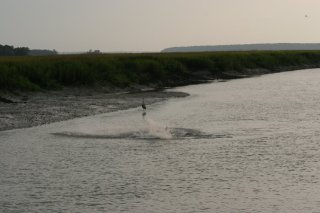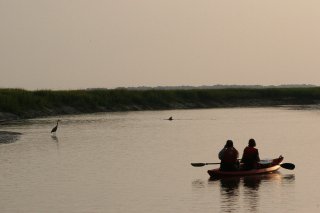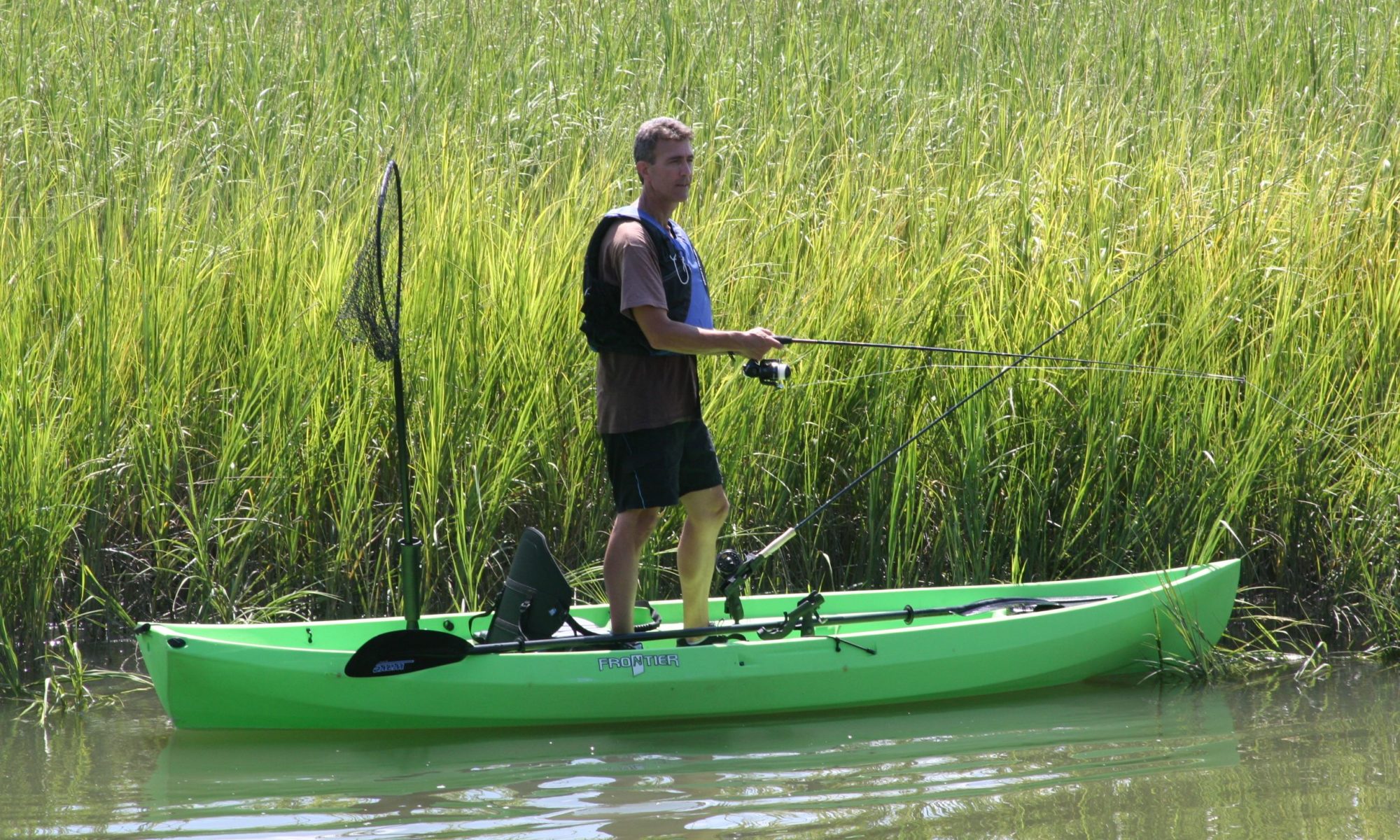Atlantic Bottle Nose Dolphin Strand Feeding in Hilton Head and the low-country.
When a lot of people come to the coast, one of the animals on most people’s list to see is the Atlantic Bottle-nose dolphin. If you are sitting out on the beach, you may see them swim parallel along the shore. For others they may like to get a little more close and personal with the dolphins. One thing unique to this area of the world is dolphin strand feeding.
 One way of doing this is signing up and taking a dolphin cruise or boat ride. Sure you get to see the dolphins and can sometimes get fairly close. The downside of this is a lot of dolphins behavior have been changed from human interaction as it is against the law to feed the dolphins. Unfortunately people have still practiced this some what since you will still find some dolphins who come up to the back of a boat almost begging like a dog at a dinner table, a trained behavior to get close. Dolphins are meant to be observed from a distance so they can remain wild and not chased like a lot of people do especially by motor boat as we have seen some do in the creek entrance since they would like to see the dolphins up close. Boat renters and some guided boat dolphin tours have occasionally interrupted the tranquility of dolphins in the area where we have not seen a mother and her baby return for a while since being chased down by sight seers. Any mother out there would not want this for their young. So please enjoy the dolphins, but at a distance where you do not intrude into their world and you might get lucky to observe dolphin strand feeding. And who knows, they may still come closer to you with curiosity, but it is on their terms.
One way of doing this is signing up and taking a dolphin cruise or boat ride. Sure you get to see the dolphins and can sometimes get fairly close. The downside of this is a lot of dolphins behavior have been changed from human interaction as it is against the law to feed the dolphins. Unfortunately people have still practiced this some what since you will still find some dolphins who come up to the back of a boat almost begging like a dog at a dinner table, a trained behavior to get close. Dolphins are meant to be observed from a distance so they can remain wild and not chased like a lot of people do especially by motor boat as we have seen some do in the creek entrance since they would like to see the dolphins up close. Boat renters and some guided boat dolphin tours have occasionally interrupted the tranquility of dolphins in the area where we have not seen a mother and her baby return for a while since being chased down by sight seers. Any mother out there would not want this for their young. So please enjoy the dolphins, but at a distance where you do not intrude into their world and you might get lucky to observe dolphin strand feeding. And who knows, they may still come closer to you with curiosity, but it is on their terms.
At Jarvis Creek we have observed several dolphins practice their communal and sometimes solo feeding in the creek. These sightings are probably unique from a kayak since it may feel like you are swimming with the dolphins when you are not. You also do not disturb the fish they are eating or the dolphin as much since you do not have a engine running. They are mainly in here to catch fish and are primarily focused on that task as they consume between 20 – 60 lbs of fish a day. Sitting across the creek channel from feeding dolphins they will occasionally become curious of us and come close to check us out before heading back to fishing.

Dolphins have a few feeding methods. Tail slapping is probably the most common we see. This is when the dolphins will use their tails to slap the water and you tend to hear a smack in order to stun the fish. They will complete this with a sweeping flourish to direct the stunned fish in the direction of hungry mouths or to shallow embankments.
Another is bubble or circle feeding. A pod or family of dolphins will swim in circles with some several feet below the surface blowing bubbles from their blow holes. This will create a circle with a curtain of bubbles capturing bait fish with-in making it easy fishing for a dolphin or two to swim through with open mouths.
The third method and unique to the low-country area of roughly 150 miles of coast line between Jacksonville, Fl and Charleston, SC is a dolphin strand feeding which can be seen in the Hilton Head area. A few reports have said there are other places in the world where they do this but with really no proven evidence on a consistent level. So, this part of the world is where it happens most frequently, been most documented and where majority will say it is the only place in the world where dolphins strand feed.

Dolphin strand feeding is a technique passed down from generation to generation of the dolphins living in the area of the ones who stay year round. Two or more dolphins, sometimes the whole pod will isolate a school of fish between them and the mostly muddy ( slippery like iced sidewalk in winter ) or slightly sandy shoreline. With a burst of energy, the dolphins will force the fish to jump up onto the mud bank as well as the waves the dolphins energy produces pushes the fish up. The dolphin will then slide up on his right side out of the water to enjoy the catch. Wildlife is no dummy and you will see multiple other birds along the bank in these areas getting the fish the dolphins may have missed.
Within a few seconds to minute later, the dolphin will slide back into the water either tail first with a little shimmy, like a child pushing themselves down a slide to get momentum. Or, they squirm around on the mud to turn head first back into the water. They may only strand feed in an area with 3 – 8 slides on average before going to a new location. During training though, I have seen along with a few lucky guest on tour watch them do it for over an hour in an area close together going back and forth between two locations.

It just takes lucky timing in seeing dolphins strand feed. We know of locations where they do it and around times of tide but they will not do it every time. It is wildlife and as much as we think we know about it and try to predict it. We are still learning and observing on nature’s own schedule. So join us or others, set down that electronic device and come out and see some of the amazing unpredictable wildlife shows with nature at is best in person, HD can not compare.
Strand Feeding Slide Show below.
These pictures below were taken 7/11 around low tide of one dolphin teaching another how to strand feed. We watched from a tour for a little while and went back to the dock. I was able to go back with my camera and get a few shots of them still practicing. Observed them practicing for a little over an hour. Photos by Mark
Quick Dolphin Facts |
|
| Weight: | 300-1400 lbs (135-635 kg), in most parts of the world they avg 450 – 650 lbs |
| Length: | 6.0-12.5 ft (~2-4 m), in most parts of the world they avg 8.5 ft |
| Lifespan: | 40-50 years; sexual maturity varies by population but ranges from 5-14 years in age |
| Diet: | Fishes, invertebrates, squids |
| Appearance: | Light gray to black |
| Behavior: | Use high frequency echolocation to locate and capture prey; use multiple feeding strategies, including “fish whacking” or “tail whipping,” where they strike a fish with their flukes and knock it out of the water or use it direct the fish towards shallows or other dolphins. Circle feeding or Bubble feeding and low-country area only strand feeding. |
| Group Size: | Between 2 and 15 but can be in larger groups off shore. |
| Mating and Birth: | Sexual maturity varies by population and ranges from 5-13 years for females and 9-14 years for males. Calves are born after a 12 month gestation period and are weaned at 18 to 20 months. On average, calving occurs every 3 to 6 years. Females as old as 45 years have given birth. |
| Threats: |
|

